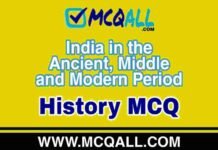Ancient India – History MCQ Question and Answer
Ancient India – History MCQ Question and Answer : Ancient India – History MCQ Question and Answer is given below. This Ancient India – History MCQ / Ancient India – History Quiz / Ancient India – History Question and Answer / Ancient India – History Multiple Choice Question, Short Question, Question and Answer, Suggestion, Notes are very important for school, college and various competitive or job exams and interviews.
Those of you who are looking for Ancient India – History MCQ Question and Answer, can read the questions and answers given below.
Ancient India 3 – History MCQ
- Which Indian king defeated Seleucus, who was appointed by Alexander to be the Administrator of Sindh and Afghanistan?
(A) Samudragupta
(B) Ashok
(C) Bindusar
(D) Chandragupta Maurya `
Answer : D
Solution: After Alexander’s death, Alexander the Most Capable General, Seleucus, commanded 305 BC to re-occupy territories occupied by Alexander. He invaded India, but was defeated by the Mauryan ruler Chandragupta Seleucus. In exchange, Chandragupta gifted him 500 elephants. According to Plutarch, Chandragupta established his aristocracy throughout India with a force of 6 lakhs.
- Who constructed the Sarnath pillar ?
(A) Harsh Vardhan
(B) Ashok
(C) Gautam Buddha
(D) Kanishka
Answer : B
Solution: Sarnath’s pillar is a monument to the Dharmachakra Enforcement event, which was created by Ashoka. The shape of a lion built on this pillar is considered a symbol of strength. It is currently known as Ashoka pillar and it has been accepted as the national mark of India by the Republic of India. All the pillars of the Mauryan age are made of sandstone. Ashok became the first Indian ruler who addressed the people with the help of his records.
- ” Arthasastra ” of Kautilya related To —
(A) Economic life
(B) Political life
(C) Religious life
(D) social life
Answer : B
Solution : Kautilya’s Arthasastra is a treatise on political science. It mainly describes political principles. It highlights the Chakravarty Emperor, the duty of the king, the detailed tax system and social status. Kautilya’s theory of kingship is in common with European philosopher Machiavelli’s theory of kingship in most forms. On this basis it is called Machiavelli of India. There are 15 tribunals, 150 episodes and 600 verses in economics.
- Which year the Kalinga war was fought ?
(A) 260 BC
(B) 261 BC
(C) 126 BC
(D) 232 BC
Answer : B
Solution: From the thirteenth inscription of Ashoka it is reported that Ashoka attacked Kalinga (present-day Orissa) in the 8th year of his coronation (261 BC) and occupied the capital of Kalinga, Tosali. In the horrific genocide of this war, Ashok abandoned the war policy and adopted the religion policy.
- The saint who inclined (attracted) Ashoka to Buddhism?
(A) Vishnu Gupta
(B) Upgupt
(C) Brahma Gupta
(D) Vrahdrath
Answer : B
Solution: Ashoka was initiated by Buddhist monk scholar Upagupta in Buddhism. These are also known as the Alachnak Buddha. After the war of Kalinga, Ashok abandoned the war policy and adopted the Dharma or Dhamma policy. Accepted Ashoka embraced Buddhism.
- In the development of Bhagwat sect, whose contribution was most ?
(A) Parthian
(B) Indo-Greek people
(C) Kushan
(D) Gupta
Answer : D
Solution: The climax of the Bhagavata or Vaishnavism took place during the reign of Gupta kings. The Gupta king was a Vaishnava matanuanyi and made it his Rajdharma. Most of the Gupta rulers held the title of ‘Parambhagavata’. Vishnu’s vehicle ‘Garuda’ was the emblem of the Guptas.
- The famous pilgrimage place of both Buddhists and Jains in Uttar Pradesh is ____________
(A) Sarnath
(B) Kaushambi
(C) Khushinagr
(D) Daviptn
Answer : B
Solution: About 33 miles southwest of Allahabad, the place called Kossam was the ancient Kaushambi. Kaushambi has been mentioned many times in Vedic and Jain literature. According to the Puranas, King Nichakshu of Hastinapur established this city after Hastinapur flowed through the Ganges. According to Jain texts, the city was named Kaushambi due to the abundance of trees called Kushamb. This city is a famous pilgrimage center for both Jains and Buddhists. Mahatma Buddha went to this city and gave sermons many times and made people his disciples. There were many viharas here. The most prominent Declaration was Ram Vihar, which was built by Declared the Best.
- Which ruler made Pataliputra his capital first?
(A) Udayin
(B) Ashok the Great
(C) Chandragupta Vikramaditya
(D) Kanishka
Answer : A
Solution: In fact, Pataliputra was founded at the confluence of the Ganges and the Son by Hariyak Vanshi ruler Udayin and shifted his capital from Rajgriha to Pataliputra.
- In whose reign did Dimacus come to India?
(A) Chandragupta Maurya
(B) Bindusar
(C) Ashok
(D) Kanishka
Answer : B
Solution: According to Strabo, King Antiochus of Syria sent one of his ambassadors named Dimacus to the royal assembly of Bindusara. It came in place of Megasthenes.
- Who among the following practiced gold coins in India for regular use?
(A) Vim Cadficz
(B) Kujul Cadfises
(C) Kanishka
(D) Harmvees
Answer : A
Solution: The Kushan dynasty Vim Kadphises, who was also the father of Kanishka I, introduced the use of gold coins in India for regular use. While the Kujul Cadfises introduced copper coins.
History MCQ Question and Answer
See also: – History MCQ Question and Answer Click Here
Ancient India – History MCQ Question and Answer
Ancient India – History MCQ Question and Answer: Ancient India – History MCQ Question and Answer – Ancient India – History MCQ Question and Answer has been discussed above.
Ancient India – History Multiple Choice Question and Answer
Ancient India – History Multiple Choice Question and Answer: Ancient India – History Multiple Choice Question and Answer – Ancient India – History Multiple Choice Question and Answer discussed above.
Ancient India – History Quiz
Ancient India – History Quiz : Ancient India – History Quiz – Ancient India – History Quiz has been discussed above.
Ancient India – History Questions and Answers in English
Ancient India – History Questions and Answers in English: Ancient India – History Questions and Answers in English – Ancient India – History Questions and Answers in English.
Ancient India – History MCQ Question and Answer
If you benefit from this “Ancient India – History MCQ Question and Answer” post then our efforts will be successful. Also visit our MCQALL.COM website to know MCQ – Multiple Choice Question Quiz on various topics, questions and answers quiz from GK and Daily Current Affairs. Thank you.












